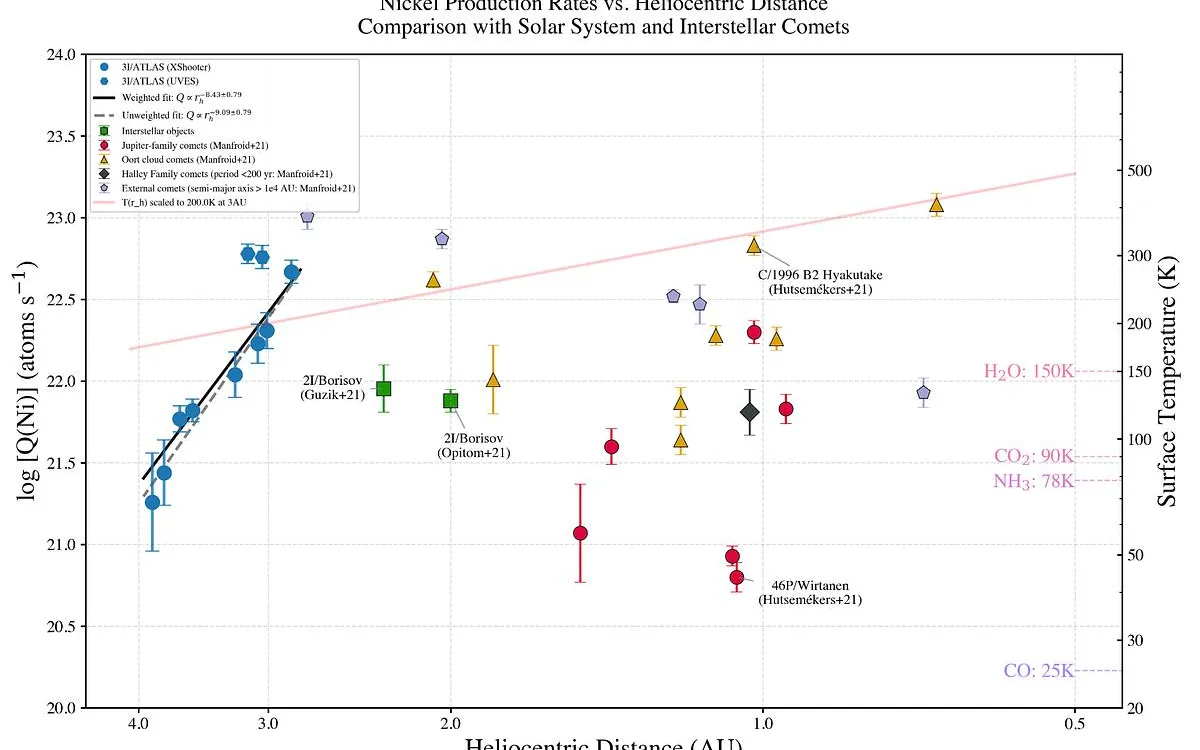
A New Discovery: Nickel Without Iron in 3I/ATLAS
A recent research paper published on spectroscopic data from the Very Large Telescope highlights a groundbreaking discovery: the detection of nickel without iron in the gas plume surrounding the interstellar object 3I/ATLAS. This finding is particularly intriguing as it deviates from the norm; typically, natural comets exhibit both iron and nickel simultaneously, as they are both produced together in supernova ejecta. This anomaly raises questions about the potential technological origin of 3I/ATLAS.
The study proposes that the formation of this unusual nickel could occur through the nickel carbonyl channel, which is an extremely rare process in cometary chemistry but is a standard method in industrial nickel refining. The data indicates that 3I/ATLAS has a nickel mass loss rate of approximately 5 grams per second when at a heliocentric distance of 2.8 astronomical units (AU) from the Sun, showing a significant increase as it approaches the Sun, with a power-law index of -8.43 (+/-0.79).
Furthermore, the spectroscopic data reveals the presence of cyanide (CN) with a mass loss rate of about 20 grams per second at 2.85 AU, exhibiting an even steeper dependence on heliocentric distance, with a power-law index of -9.38 (+/-1.2). These findings align with previous anomalies suggested by the SPHEREx space observatory and the Webb space telescope, which indicated that the gas plume around 3I/ATLAS is predominantly composed of 95% CO2 and only 5% H2O, a stark contrast to the expectation of a water-rich comet.
The hypothesis that the nucleus of 3I/ATLAS is considerably smaller than the 46-kilometer diameter inferred from SPHEREx data raises intriguing questions about its structure. For the observed dust coma to effectively reflect sunlight, it would need to be dense enough to obscure the nucleus, pushing dust particles to trail behind, thus creating a cometary tail. However, images from the Hubble Space Telescope show no such tail, which complicates our understanding of the object's behavior.
If, conversely, the surface of the nucleus reflects most sunlight, this could imply that 3I/ATLAS is significantly more massive—potentially a million times more than the previous interstellar object, 2I/Borisov. This raises further questions about the trajectory of 3I/ATLAS. Its finely-tuned alignment with the ecliptic plane suggests a possible technological design aimed at targeting the inner solar system, a theory I proposed shortly after its discovery.
Currently, I am in Copenhagen, where I was invited to speak at a conference titled "Current Themes in Astrophysics and Particle Physics 2025," attended by notable figures, including Nobel laureate David Gross. Copenhagen is famed among physicists for being the birthplace of the Copenhagen interpretation of quantum mechanics. Sitting in Auditorium A at the Niels Bohr Institute, I couldn't help but reflect on the legacy of great physicists who once occupied this space, such as Niels Bohr and Werner Heisenberg.
My lecture, which was split into two segments—black holes and interstellar objects—sparked significant interest, particularly in the Q&A session, where audience members were eager to discuss 3I/ATLAS. David Gross posed questions about the implications of the object's emissions and whether there’s evidence for non-gravitational acceleration. The feedback was overwhelmingly positive, marking a rare moment in my 45-year career where genuine curiosity was palpable.
Looking ahead, on October 3, 2025, 3I/ATLAS will come within 29 million kilometers of Earth, allowing the HiRISE camera onboard the Mars Reconnaissance Orbiter to capture high-resolution images. This observation could help differentiate between the nucleus and coma contributions to the reflected sunlight, providing more clarity on the object's size.
Moreover, David Gross suggested utilizing radio telescopes to monitor 3I/ATLAS for any potential technological signals. Given that humanity has been broadcasting radio signals for over a century, this could be an opportunity for interstellar communication. If 3I/ATLAS originated from the inner edge of the Oort Cloud, its journey may coincide with the advent of routine radio transmissions on Earth, raising fascinating implications about our interactions with potential extraterrestrial technologies.
As we continue to explore the mysteries of 3I/ATLAS, there is an underlying tension between the hope that it may simply be a CO2-rich comet and the fear that it could signal more advanced alien technology. This encounter could serve as a vital reminder for humanity about our place in the cosmos. The discourse surrounding 3I/ATLAS, coupled with recent advancements in AI, suggests that we are on the brink of new discoveries that could redefine our understanding of the universe.